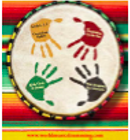World Music Drumming Objectives
Upon completion of the curriculum students will:
- Communicate better with their fellow students and others by having learned:
- how to listen to others,
- respect for the need of others to have their own musical and personal space,
- the importance of leaving spaces (silence) for others to drum (speak),
- how to lead and how to follow (solo and back– up).
- Understand and demonstrate the value and techniques of cooperative teamwork.
- Demonstrate techniques for playing various types of drums and other percussion equipment.
- Sing songs with percussion and other instruments from various multicultural traditions.
- Improvise new drumming ensemble patterns which are complementary to those played by other students.
- Move to music while singing or playing instruments.
- Create (with a small group of fellow students) new drum ensembles in the style of various drumming traditions.
- Listen actively and critically to various styles of music which include percussion. While listening, students will:
- echo drum patterns played by others
- identify the type of instruments being played
- recognize and label styles of music
- identify the probable culture from which the music comes.
- Understand and place greater value on the peoples and musical cultures of Africa and the Caribbean. Students will:
- describe the way drumming is done in at least two contrasting traditions
- discuss how traditional drumming may be the same or different from contemporary styles in various cultures
- have greater respect for the people represented by the traditions studied.
- Understand how music reflects similar cultural themes and patterns found in art, dance, literature, social patterns, work, etc. of the cultures studied

